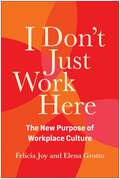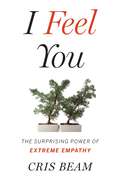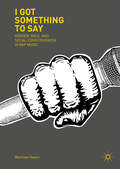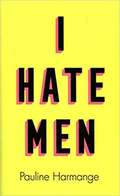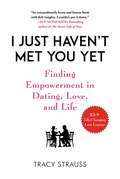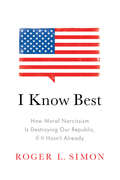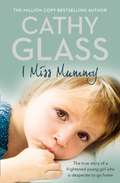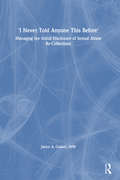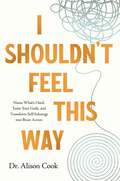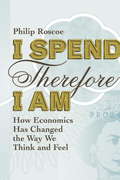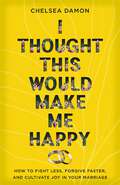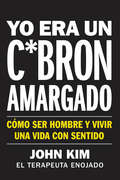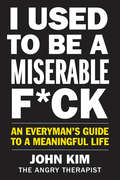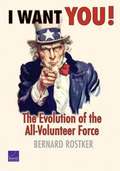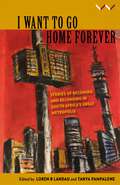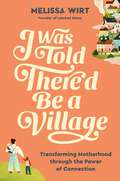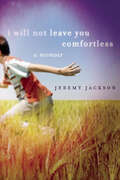- Table View
- List View
I Do and I Don't: A History of Marriage in the Movies
by Jeanine BasingerFrom one of our leading film historians and interpreters: a brilliantly researched, irresistibly witty, delightfully illustrated examination of "the marriage movie"; what it is (or isn't) and what it has to tell us about the movies--and ourselves.As long as there have been feature movies there have been marriage movies, and yet Hollywood has always been cautious about how to label them--perhaps because, unlike any other genre of film, the marriage movie resonates directly with the experience of almost every adult coming to see it. Here is "happily ever after"--except when things aren't happy, and when "ever after" is abruptly terminated by divorce, tragedy . . . or even murder. With her large-hearted understanding of how movies--and audiences--work, Jeanine Basinger traces the many ways Hollywood has tussled with this tricky subject, explicating the relationships of countless marriages from Blondie and Dagwood to the heartrending couple in the Iranian A Separation, from Tracy and Hepburn to Laurel and Hardy (a marriage if ever there was one) to Coach and his wife in Friday Night Lights. A treasure trove of insight and sympathy, illustrated with scores of wonderfully telling movie stills, posters, and ads.
I Do!: A Marriage Workbook for Engaged Couples
by Jim WalkupMake your bond stronger than ever on your way to the altarPlanning can be the key to a happy and satisfying marriage. The in-depth, thought-provoking exercises in this marriage workbook will help you and your partner grow your love and solidify your partnership as you prepare to walk down the aisle.Dig deep into your relationship over the course of 7 chapters—each focusing on a different part of married life. Gain insight into each other, and discover ways to feel closer before you finally say, "I do!"A look into the future—Prepare for a lifetime together by exploring your feelings on communication, money, intimacy, children, beliefs, work, and family and friends.In-depth exercises—Learn more about your partner through various exercises, including writing prompts, true/false questionnaires, worksheets, discussion topics, and more.Expert guidance—Author Jim Walkup is a licensed marriage and family therapist with more than 40 years of experience working with couples from all backgrounds who want to make their marriage last.Set the stage for a happy and successful marriage with this premarital counseling workbook for couples.
I Don't Just Work Here: The New Purpose of Workplace Culture
by Felicia Joy Elena GrottoWork isn&’t what it used to be. Leaders need a field guide that equips them with what to say and do as they face the new culture expectations of today&’s employees. Many employees now show up for work not just to do their jobs but also to discover, debate, and digest important social issues. A growing number of workers want to have an impact in the world, and their preferences are a prompt for employers to be more mindful of the role of business in driving societal change, starting with what people experience at work. Felicia Joy and Elena Grotto, experts on behavioral science, business strategy, and organizational culture, share practical guidance to help organizations rise to these new standards by advancing seven behaviors, including the surprising—and perhaps most important—new business skill for high-performing cultures: forgiveness. Managers today are asked to operate as both business leaders and community leaders within the workplace—and the latter skillset is new to many. I Don&’t Just Work Here helps managers leverage culture to bolster business results as they replace anxiety with confidence and lead with greater purpose in providing the expanded support employees need to develop and perform. Organizations that take heed, elevate people managers, invest in building a strategic culture, and lead with clear values and behaviors are more likely to have a decisive competitive advantage and greater business impact for years to come.
I Feel You: The Surprising Power of Extreme Empathy
by Cris BeamA cogent, gorgeous examination of empathy, illuminating the myths, the science, and the power behind this transformative emotion Empathy has become a gaping fault line in American culture. Pioneering programs aim to infuse our legal and educational systems with more empathic thinking, even as pundits argue over whether we should bother empathizing with our political opposites at all. Meanwhile, we are inundated with the buzzily termed &“empathic marketing&”—which may very well be a contradiction in terms. In I Feel You, Cris Beam carves through the noise with a revelatory exploration of how we perform empathy, how it is learned, what it can do—indeed, what empathy is in the first place. She takes us to the labs where the neural networks of compassion are being mapped, and the classrooms where children are being trained to see others&’ views. Beam visits courtrooms and prisons, asking how empathy might transform our justice system. She travels to places wracked by oppression and genocide, where reconciliation seems impossible, to report on efforts to heal society&’s deepest wounds through human connection. And finally, she turns to how we, as individuals, can foster compassion for ourselves. Brimming with the sensitive and nuanced storytelling that has made Beam one of our most respected journalists, I Feel You is an eye-opening affirmation of empathy&’s potential.
I Got Something to Say: Gender, Race, and Social Consciousness in Rap Music
by Matthew OwareWhat do millennial rappers in the United States say in their music? This timely and compelling book answers this question by decoding the lyrics of over 700 songs from contemporary rap artists. Using innovative research techniques, Matthew Oware reveals how emcees perpetuate and challenge gendered and racialized constructions of masculinity, femininity, and sexuality. Male and female artists litter their rhymes with misogynistic and violent imagery. However, men also express a full range of emotions, from arrogance to vulnerability, conveying a more complex manhood than previously acknowledged. Women emphatically state their desires while embracing a more feminist approach. Even LGBTQ artists stake their claim and express their sexuality without fear. Finally, in the age of Black Lives Matter and the presidency of Donald J. Trump, emcees forcefully politicize their music. Although complicated and contradictory in many ways, rap remains a powerful medium for social commentary.
I Hate Men
by Natasha Lehrer Pauline HarmangeWomen, especially feminists and lesbians, have long been accused of hating men. Our instinct is to deny it at all costs. (After all, women have been burnt at the stake for admitting to less.) <p><p> But what if mistrusting men, disliking men – and yes, maybe even hating men – is, in fact, a useful response to sexism? What if such a response offers a way out of oppression, a means of resistance? What if it even offers a path to joy, solidarity and sisterhood? <p> In this sparkling essay, as mischievous and provocative as it is urgent and serious, Pauline Harmange interrogates modern attitudes to feminism and makes a rallying cry for women to find a greater love for each other – and themselves.
I Have Always Been Me: A Memoir
by Precious Brady-DavisIn July 2023, Precious Brady-Davis became the first black trans woman to be appointed to a commissioner position at the Metropolitan Water Reclamation District of Greater Chicago. In 2021 she published this book telling her story. Born into traumatic circumstances, Davis was brought up in the Omaha foster care system and the Pentecostal faith. As a biracial, gender-nonconforming kid, she felt displaced. Yet she realized by coming into her identity that she had a purpose all along. In I Have Always Been Me, Brady-Davis reflects on a childhood of neglect, instability, and abandonment. She reveals her determination to dream through it and shares her profound journey as a trans woman now fully actualized, absolutely confident, and precious. She is an award-winning diversity advocate, communications professional, and public speaker. She is married to Myles Brady and lives in Hyde Park on the South Side of Chicago, where they are raising their daughter, Zayn. In her free time, she enjoys online shoe shopping, travel, and fine dining with friends. For more information visit www.preciousbradydavis.com.
I Hope This Email Finds You Never: A Complete Guide to Blissfully Surviving the Modern Workplace
by Ken Kupchik Emily Ann HillAhhh, the modern workplace: a cauldron of stress and anxiety. From the moment we accept a new role, we&’re thrown into a world of competing personalities, shifting protocols, and an endless stream of emails, Slack messages, and Zoom calls, all of which serve to distract us from the things we truly want to be doing, like eating Thai food and sleeping until noon.I Hope This Email Finds You Never puts aside the motivational screeds, productivity hacks, and pop-science, and focuses instead on those things in the workplace that truly cause us grief—like a coworker eating an apple during a video call—in a lighthearted, entertaining, and (most importantly) cynical way.Some things you&’ll learn:How long you can get away with being &“new&” until you&’re held accountableHow to make it look like you&’re sorry without giving up any powerHow to find a workplace friend and make a workplace enemy Camera position: how to set up your laptop for maximum dominanceOrganizing your calendar while leaving time to cryThe rules of the kitchen (stealing someone&’s yogurt is literally a crime)Writing a letter of resignation when you&’ve already been resigned from day one From Orientation (The Descent), Workplace Etiquette (No Eye Contact Before 11 AM), Working Remotely (Wink Wink), Coworkers (Getting Along with your fellow inmates), and everything in between, I Hope This Email Finds You Never is your must-have guide to surviving (thriving is not realistic) in the modern workplace.
I Is an Other: The Secret Life of Metaphor and How It Shapes the Way We See the World
by James GearyThe New York Times bestselling author examines how metaphors influence every aspect of our lives, from art to medicine, psychology to the stock market.Metaphor is much more than a mere literary device. Often hiding in plain sight, it is a critical aspect of how humans think and communicate. Metaphor is at work in all fields of human endeavor, including economics, business, science, and psychology.In I Is an Other, James Geary takes readers from Aristotle's investigation of metaphor right up to the latest neuroscientific insights into how metaphor works in the brain. Along the way, he demonstrates how metaphor affects financial decision making, creates effective advertising, and helps us achieve emotional insight and psychological change. Geary also explores how a life without metaphor, as experienced by some people with autism spectrum disorders, significantly changes the way a person interacts with the world.
I Just Haven't Met You Yet: Finding Empowerment in Dating, Love, and Life
by Tracy StraussA Modern-Day Bridget Jones’s Diary Meets Eat, Pray, Love, One of Bustle’s “Writers to Watch” Offers Advice, Life Lessons, and Lots of HeartI Just Haven’t Met You Yet details Tracy Strauss’s dating history and her journey to dismantle the effects and stigmas of an abusive past, break free of destructive relationship patterns, and ultimately conquer her fear of truly being seen by the world, flaws and all. The author shares the transformative lessons she learned and self-empowerment she achieved while passing each hurdle along the way to finding the love of her life. Tracy Strauss helps readers empower themselves by taking a challenging look at the ways the negative events of their lives, including sexual harassment and abuse, have shaped their self-perception and created obstacles to personal success, and how readers can change that troubled self-image along with their (love) lives. I Just Haven’t Met You Yet is a modern-day journey of the heart. It is a story about taking big risks, changing old habits and beliefs about dating, and speaking back to the naysayers, especially that internal critic, the inner love saboteur. It is a prime mover and the only epistolary memoir cum dating/relationship essay book of its kind.
I Know Best: How Moral Narcissism Is Destroying Our Republic, If It Hasn't Already
by Roger L. SimonIn 1979, Christopher Lasch published the epochal The Culture of Narcissism warning of the normalizing of narcissism in our society. Lasch may have understated it. 35 years later, in the Obama era-with its parade of endless, often inexplicable, scandals-we have a full blown epidemic of what has recently been called Moral Narcissism.Forget Narcissus and his reflection, Moral Narcissism-the almost schizophrenic divide between intentions and results now pervading our culture-is the new method for feeling good about yourself. It no longer matters how anything turns out as long as your intentions were good, that you were "moral." And, just as importantly, the only determinant of those intentions, the only one who defines that morality, is you.I Know Best goes beyond Lasch to lay bare how this moral narcissism is behind all those scandals from Obamacare to the Veteran's Administration to the IRS, Benghazi, Bergdahl, Syria and beyond. Everything the Obama administration did and does was about making them feel good about themselves-the results be damned.And they have as their allies those supreme moral narcissists in the academy, media and Hollywood, ever willing to ratify those good intentions and ignore those same results.But I Know Best is not just about the Left. Moral Narcissism affects the right as well, even when they don't realize it. It is a true epidemic that must be cured in order to save our democratic republic and our futures.
I Love It When You Talk Retro: Hoochie Coochie, Double Whammy, Drop a Dime, and the Forgotten Origins of American Speech
by Ralph KeyesAn entertaining and informative book about the fashion and fads of language Today's 18-year-olds may not know who Mrs. Robinson is, where the term "stuck in a groove" comes from, why 1984 was a year unlike any other, how big a bread box is, how to get to Peyton Place, or what the term Watergate refers to. I Love It When You Talk Retro discusses these verbal fossils that remain embedded in our national conversation long after the topic they refer to has galloped off into the sunset. That could be a person (Mrs. Robinson), product (Edsel), past bestseller (Catch-22), radio or TV show (Gangbusters), comic strip (Alphonse and Gaston), or advertisement (Where's the beef?) long forgotten. Such retroterms are words or phrases in current use whose origins lie in our past. Ralph Keyes takes us on an illuminating and engaging tour through the phenomenon that is Retrotalk—a journey, oftentimes along the timelines of American history and the faultlines of culture, that will add to the word-lover's store of trivia and obscure references. "The phrase "drinking the Kool-Aid" is a mystery to young people today, as is "45rpm." Even older folks don't know the origins of "raked over the coals" and "cut to the chase." Keyes (The QuoteVerifier) uses his skill as a sleuth of sources to track what he calls "retrotalk": "a slippery slope of puzzling allusions to past phenomena." He surveys the origins of "verbal fossils" from commercials (Kodak moment), jurisprudence (Twinkie defense), movies (pod people), cartoons (Caspar Milquetoast) and literature (brave new world). Some pop permutations percolated over decades: Radio's Take It or Leave It spawned a catch phrase so popular the program was retitled The $64 Question and later returned as TV's The $64,000 Question. Keyes's own book Is There Life After High School? became both a Broadway musical and a catch phrase. Some entries are self-evident or have speculative origins, but Keyes's nonacademic style and probing research make this both an entertaining read and a valuable reference work." --Publishers Weekly
I Love Suburbia: The Joys of Life on London’s Outskirts
by Simon Pollock'Brilliant. London never looked so good. A glorious celebration of the city that will leave a big smile on your face.’ Daisy May Cooper'This book celebrates suburbia in all its quirky glory' Daily MailSEE LONDON IN A NEW LIGHT THROUGH STORIES AND PHOTOS OF OVER 100 HIDDEN SPOTS IN THE SUBURBSHow many of us have marvelled at the unexpected beauty of an art deco cinema, had our heads turned by the magnificent Hoover Factory on the A40, or wondered at a mosaic-covered house in Chiswick?From stations that wouldn't be out of place in Miami Beach to cinemas converted to megachurches, I Love Suburbia brings to life the joys of living outside Zone 1. Step back in time and revisit simpler days in the suburbs to discover the pioneering interwar architects who brought modernism to Britain, or delight in the elegance of Art Deco buildings given a new lease of life. Filled with stories of the people who live, work and play in the outskirts of London, this full-colour book is an exploration of the capital’s overlooked everyday treasures.Brought together by Simon Pollock, the creator of Instagram’s heartwarming @LondonSuburbia, with over 200 original photos of unusual charm from Chingford to Leatherhead, Beaconsfield to Becontree, this is the suburbs as you've never seen them before.
I Miss Mummy
by Cathy GlassIn her new book, Cathy Glass, the no. 1 bestselling author of Damaged, tells the story of Alice, a young and vulnerable girl who is desperate to return home to her mother. Alice, aged four, is snatched by her mother the day she is due to arrive at Cathy's house. Drug-dependent and mentally ill, but desperate to keep hold of her daughter, Alice's mother snatches her from her parents' house and disappears. Cathy spends three anxious days worrying about her whereabouts before Alice is found safe, but traumatised. Alice is like a little doll, so young and vulnerable, and she immediately finds her place in the heart of Cathy's family. She talks openly about her mummy, who she dearly loves, and how happy she was living with her maternal grandparents before she was put into care. Alice has clearly been very well looked after and Cathy can't understand why she couldn't stay with her grandparents. It emerges that Alice's grandparents are considered too old (they are in their early sixties) and that the plan is that Alice will stay with Cathy for a month before moving to live with her father and his new wife. The grandparents are distraught Alice has never known her father, and her grandparents claim he is a violent drug dealer. Desperate to help Alice find the happy home she deserves, Cathy's parenting skills are tested in many new ways. Finally questions are asked about Alice's father suitability, and his true colours begin to emerge.
I Never Told Anyone This Before: Managing the Initial Disclosure of Sexual Abuse Re-Collections
by Janice A Gasker“I Never Told Anyone This Before” is the first book that will enable you to work in an ethical, effective manner, based on empirically tested guidelines, with clients who disclose memories of sexual abuse You'll find that these guidelines result in the creation of a helping environment conducive to the sharing of traumatic re-collections. At the same time, this environment is structured to keep you free from legal risk amidst the “false memory” debate era.With “I Never Told Anyone This Before”, you will overcome your specific concerns for working with special populations, such as persons who aren&’t sure they&’ve been abused, persons who are nonverbal, men, and persons who have suffered head injuries. This book also provides you with a language for discussing sexual abuse memories in a manner that focuses on the clients&’ experiences. You will explore practice techniques that are based on theoretical foundations, as well as real helping situations with examples from actual therapy sessions. Other specific areas you will learn about in “I Never Told Anyone This Before” include: how to facilitate and manage first-time disclosure of abuse stories therapeutic use of memories of sexual abuse the function of memory in identity formation facilitation of disclosures of traumatic history avoiding legal risks for therapists in view of the false memory debate memory as it is treated by psychodynamic, cognitive, and developmental theorists caveats for researching the disclosure of sexual abuse re-collectionsFaced with the prospect of working with a possible survivor of childhood sexual abuse, you may be unsure about the therapeutic approach to take. Current controversy highlights the possibility that persons may be harmed rather than helped in the therapeutic process. “I Never Told Anyone This Before” provides you with a combination of theory, research, and practice that will put your anexities at ease.
I Shouldn't Be Telling You This: Success Secrets Every Gutsy Girl Should Know
by Kate WhiteNew York Times bestselling author Kate White is the editor-in-chief of Cosmopolitan, the #1 young women’s magazine in the world, and a hugely successful businesswoman. In I Shouldn’t Be Telling You This, she shares her secrets to success. A witty, wise, straight-talking career guide for women, I Shouldn’t Be Telling You This is the perfect book for the current economic climate, whether you’re just starting out, re-entering the workforce after maternity leave, or simply looking for a career change; essential tips and bold strategies from a gutsy innovator who helped increase Cosmo’s circulation by half a million copies per month.
I Shouldn't Feel This Way: Name What’s Hard, Tame Your Guilt, and Transform Self-Sabotage into Brave Action
by Alison Cook, PhDYou can find emotional freedom. Learn to see through the haze of conflicted feelings and move forward in your life with confidence. Licensed therapist and bestselling author Dr. Alison Cook guides you through a groundbreaking 3-step process to find the freedom you crave.When you're tangled up inside, it's hard to find clarity. Yet so many of us guilt-trip or gaslight ourselves instead of working our way through complicated feelings….I should be a good friend, even though I feel hurt by past betrayals.I should be content, even though I feel lonely or unfulfilled.I should just have faith, even though I feel discouraged by unanswered prayers. This jumbled-up knot is a cry for gentle care and patient attention, but most of us haven't been given the tools required to unravel it.I Shouldn't Feel This Way is your guide out of the chaos and into the calm and clarity you need to face life's challenges. Drawing from over twenty years of research and clinical practice, Dr. Alison Cook guides you through a groundbreaking 3-step process that has helped tens of thousands of people find emotional freedom and surprisingly simple breakthroughs. Dr. Alison shows you how to:identify guilt and know what to do with it,trade feeling stuck in your head for clarity,move from comfortable numbing to courageous conversations, andmake decisions that break cycles of defeat. Change starts when you finally stop beating yourself up for the way that you feel. I Shouldn't Feel This Way is your pathway to emotional freedom. It is time to finally work through your complicated feelings so you can start living with the clarity and confidence you crave.
I Spend Therefore I Am
by Philip RoscoeA powerful exploration of how economic thinking has infiltrated every aspect of modern life, even our understanding of who we are and what it means to be a person. Economics is the academic success story of the 20th century, a potent force not just in markets and government, but in our everyday lives. It affects our decisions as consumers, of course, but also our education, our health, our social lives and our family relationships. In his trenchant book, Philip Roscoe argues that the justifications of economics allow us to set aside social or moral obligations and to act instead within a limited, short-term definition of self-interest. This attitude, and these justifications, are responsible for the gravest problems we face, from global financial meltdown to environmental threat. I Spend Therefore I Am shows how our daily activities, our values, and even our understanding of what it is to be a person have been changed for the worse by economics, a discipline, he writes, "at war with the goods of life."
I Thought This Would Make Me Happy: How to Fight Less, Forgive Faster, and Cultivate Joy in Your Marriage
by Chelsea DamonWhat happened to us?Why is there no joy, no friendship in our marriage?Why don't we feel like a team anymore?If you've ever felt this way about your marriage, you're not alone. Marriage is hard. Every couple comes to a place of disappointment and distance at one point or another. The good news is that your relationship can get better. If you're both willing to work at it, it can work out. Teacher, author, and creator of "Living the Sweet Wife" Chelsea Damon has coached thousands of couples through the hardest seasons of their marriage. In I Thought This Would Make Me Happy, she'll help you take your first steps to a renewed and life-giving marriage. You'll gain the tools you need to:Identify the problems—Anger, bitterness, and resentment arise in all marriages. You'll learn how to assess what the problems are and step away from destructive patterns.Restore harmony—Reflection sections and journal exercises are specially designed to help you and your spouse forgive each other and communicate more deeply.Cultivate the good qualities—Each chapter is designed to help you and your spouse build the characteristics that make a marriage reflect Christ and grow stronger. With stories, practical tips, and biblical truths, I Thought This Would Make Me Happy will show you a way forward. Your relationship with your spouse may be in a difficult season...but it can get better.A marriage full of joy, grace, and unity is possible
I Used to Be a Miserable F*ck \ Yo era un c*brón amargado (Spanish edition): Cómo ser hombre y vivir una vida con sentido
by John KimEl terapeuta enojado (The Angry Therapist) que ha ayudado a miles de hombres a encontrar más felicidad en sus relaciones y más propósito en sus vidas ahora comparte sus ideas con todos en esta poderosa y concisa guía de autoayuda, que cubre temas esenciales, desde la vulnerabilidad y las actitudes pretenciosas hasta los ejercicios y la mujer.Después de pasar por un divorcio y buscar profundamente dentro de su alma, John Kim llegó a una asombrosa realización: era un c*abrón amagado y que era el único responsable de los problemas en su vida. Armado con esta nueva perspectiva, comenzó el blog The Angry Therapist, una admisión de que, mientras era un terapeuta y entrenador de vida autorizado, no era mejor que las personas que buscaban su consejo. En su primer escrito, "My Fucking Feelings", escribió sobre las dificultades y las deficiencias que lo habían llevado a este punto. A medida que avanzaba su trabajo, catapultándolo al rol de guía poco convencional y poco convencional para miles de personas en todo el mundo, Kim evolucionó de comportarse como un niño a vivir como un hombre, y mostró a sus clientes cómo hacerlo también.En Yo era un c*brón amargado, Kim reflexiona en lo que debe y lo que no debe hacer para mejorar su condición de hombre, lo que define como hombre de acuerdo a su transparencia y fuerza de carácter, no por abdominales o la mejor oficina. Con su exclusivo enfoque, despreocupado y liviano que te hará reír y pensar. Kim te llevará a un viaje inusual y accidentado de autoexploración y descubrimiento. Compartirá su sabiduría e información, en asuntos de cómo por qué:• Ser agradable es para los niños, y ser amable es para los hombres • Hacer tiempo para los amigos podría convertirte en un mejor amigo, amante y ser humano” • Orinarse en la ducha es un signo de un problema mayor • Discutir, juzgar y responder, "No lo sé" te impide tener una relación saludable, una gran carrera y una vida feliz No nacemos ya hombres. Nacemos niños. La transición de la miseria a encontrar el sentido, es un proceso interno que requiere trabajo: reflexión, dolor, valor y, a veces, un renacimiento. Kim lo sabe porque él ha estado allí. La verdad es que los hombres no estaban destinados solo a pagar facturas y morir. Con este libro como guía, amarás mucho, caminarás alto y encontrarás una vida llena de propósito y pasión.
I Used to Be a Miserable F*ck: An Everyman's Guide to a Meaningful Life
by John KimThe Angry Therapist who has helped thousands of men find more happiness in their relationships and more purpose in their lives now shares his insights with everyone in this powerful guide—self-help in a shotglass—covering essential topics, from vulnerability and posturing to workouts and women.Deep in post-divorce soul searching, John Kim came to an astonishing realization: he was a miserable f*ck who might just be to blame for the problems in his life. Armed with this new insight, he began The Angry Therapist blog—an admission that, while he was a licensed therapist and life coach, he was no better than the people who sought his advice. In his first post, “My Fucking Feelings,” he wrote about the struggles and shortcomings that had led him to this point. As his work caught on, catapulting him into the role of unlikely and unconventional guide for thousands of people all over the world, Kim evolved from behaving like a boy to living like a man—and showed his clients how to do so as well.In I Used to Be a Miserable F*ck, Kim delivers the dos and don’ts for stepping up and into manhood, which he defines by transparency and strength of character, not six-pack abs or a corner office. With his signature no-nonsense approach that will make you laugh and think, Kim takes you on a rugged, rough and tumble road trip of self-exploration and discovery, sharing his wisdom and insights, such as why:Being nice is for boys, and being kind is for menScheduling man dates could make you a better friend, lover, and human beingPeeing in the shower is a sign of a larger problemArguing, judging, and answering, “I dunno” are keeping you from a healthy relationship, a great career, and a happy lifeWe are not born men. We are born boys. The transition from misery to meaning is an internal process that requires work: reflection, pain, courage, and sometimes, a rebirth. Kim knows because he’s been there. The truth is, men weren’t meant to just pay bills and die. With this book as your guide, you will love hard, walk tall, and find a life filled with purpose and passion.
I Want You!
by Bernard D. Rostker K. C. YehAs U.S. military forces appear overcommitted and some ponder a possible return to the draft, the timing is ideal for a review of how the American military transformed itself over the past five decades, from a poorly disciplined force of conscripts and draft-motivated "volunteers" to a force of professionals revered throughout the world. Starting in the early 1960s, this account runs through the current war in Iraq, with alternating chapters on the history of the all-volunteer force and the analytic background that supported decisionmaking. The author participated as an analyst and government policymaker in many of the events covered in this book. His insider status and access offer a behind-the-scenes look at decisionmaking within the Pentagon and White House. The book includes a foreword by former Secretary of Defense Melvin R. Laird. The accompanying DVD contains more than 1,700 primary-source documents-government memoranda, Presidential memos and letters, staff papers, and reports-linked directly from citations in the electronic version of the book. This unique technology presents a treasure trove of materials for specialists, researchers, and students of military history, public administration, and government affairs to draw upon.
I Want to Go Home Forever: Stories of becoming and belonging in South Africa's great metropolis
by Loren B Landau and Tanya PampaloneThirteen true stories about xenophobia and belonging in JohannesburgGenerations of people from across Africa, Europe and Asia have turned metal from the depths of the earth into Africa’s wealthiest, most dynamic and most diverse urban centre, a mega-city where post-apartheid South Africa is being made. Yet for newcomers as well as locals, the golden possibilities of Gauteng are tinged with dangers and difficulties. Chichi is a hairdresser from Nigeria who left for South Africa after a love affair went bad. Azam arrived from Pakistan with a modest wad of cash and a dream. Estiphanos trekked the continent escaping political persecution in Ethiopia, only to become the target of the May 2008 xenophobic attacks. Nombuyiselo is the mother of 14-year-old Simphiwe Mahori, shot dead in 2015 by a Somalian shopkeeper in Snake Park, sparking a further wave of anti-foreigner violence. After fighting white oppression for decades, Ntombi has turned her anger towards African foreigners, who, she says are taking jobs away from South Africans and fuelling crime. Papi, a freedom fighter and activist in Katlehong, now dedicates his life to teaching the youth in his community that tolerance is the only way forward. These are some of the thirteen stories that make up this collection. They are the stories of South Africans, some Gauteng-born, others from neighbouring provinces, striving to realise the promises of democracy. They are also the stories of newcomers, from neighbouring countries and from as far afield as Pakistan and Rwanda, seeking a secure future in those very promises. The narratives, collected by researchers, journalists and writers, reflect the many facets of South Africa’s post-apartheid decades. Taken together they give voice to the emotions and relations emanating from a paradoxical place of outrage and hope, violence and solidarity. They speak of intersections between people and their pasts, and of how, in the making of selves and the other they are also shaping South Africa. Underlying these accounts is a nostalgia for an imagined future that can never be realised. These are stories of forever seeking a place called ‘home’.
I Was Told There'd Be a Village: Transforming Motherhood through the Power of Connection
by Melissa WirtMelissa Wirt recounts her journey and dozens of others in building a supportive &“village&” to transform oppressive, solitary motherhood into a connected—even joyful—endeavor. Melissa Wirt thought she had everything—she'd built her own company and moved to a beautiful farm with her family. Then during a personal crisis, she realized that despite having created an online community reaching thousands of moms, she&’d also somehow, become utterly isolated. In I Was Told There'd Be a Village, Melissa leads us through the small changes she made to seek out connection. She also recounts how she talked to mothers from across the country, and soon saw that the beliefs keeping each of us parenting solo – I don&’t have time; my life is too messy – were also keeping us from accessing our most powerful resource: each other. The stories she uncovered, combined with her own, became a foundation for slowly building back community. That journey starts with an intentional shift from an isolation mindset to a village mindset. It might be as simple as smiling at the mom next to you at story-time or sending a quick text to a friend. But it can be much bigger, eventually growing into a thriving, supportive community. Motherhood shouldn&’t be this hard, and it doesn&’t have to be. Here, at last, is a roadmap for finding your village.
I Will Not Leave You Comfortless: A Memoir
by Jeremy JacksonThis memoir of “a happy childhood in rural Missouri just before the digital revolution [is] a sweet record of a time and a place that was not Always On.” —St. Louis Post-DispatchSpanning one year of the author’s life—1984—I Will Not Leave You Comfortless is the intimate memoir of a young boy coming to consciousness in small-town Missouri. The year will bring ten-year-old Jeremy first loves, first losses, and a break from the innocence of boyhood that will never be fully repaired. For Jeremy, the seeming security of his life on the family farm is forever shaken by the life-altering events of that pivotal year. Throughout, he recalls the deeply sensual wonders of his rural Midwestern childhood—bicycle rides in September sunlight; the horizon vanishing behind tall grasses—while stories both heart-wrenching and humorous, tragic and triumphant, Jackson weaves past, present, and future into the rich Missouri landscape.“I could smell the mulberries crushed underfoot and the sweet steam of the cinnamon roll Grandma heated in the toaster oven just for Jeremy, hear the ever-increasing volume of an approaching late-spring storm . . . The year of Jeremy Jackson’s life on which he meditates in I Will Not Leave You Comfortless marked his transition from the perfect happiness of childhood to the much more complex reality of adulthood. It records, as well, the abiding comfort that remains—family, home and love.” —Wichita Eagle“Jackson writes about Missouri as the young Hemingway wrote about Michigan: with a clear eye; with hard-edged nostalgia; and (here’s the thing) with brilliance.” —Darin Strauss, author of Half a Life


